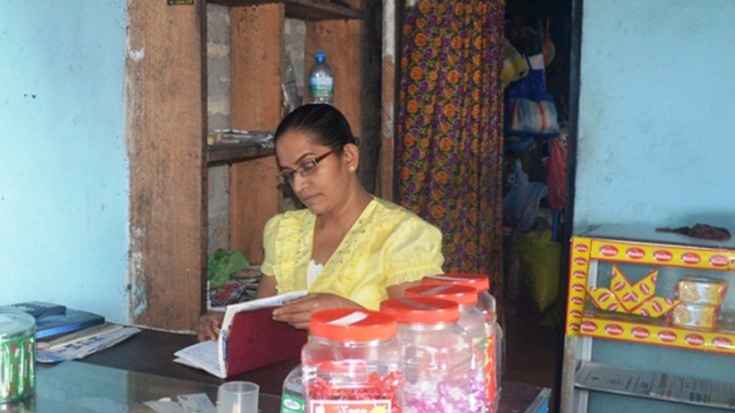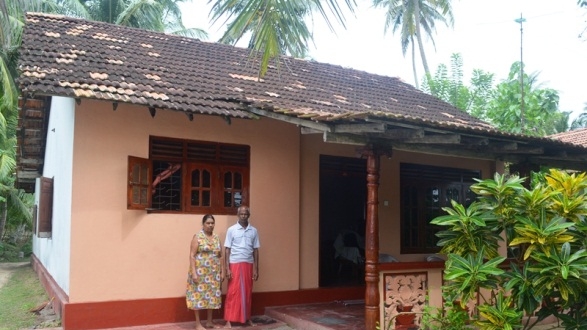Immediate Relief
“Although it’s been 10 years, I do not like to recollect the memory of the tsunami,” said L.W. Chandrakanthi, a proprietor of a successful family business who had spent 10 years meeting many challenges rebuilding her life. She lost her husband two years ago in a road accident. “I do get some relief every time I share my story and people listen to me with empathy,” she said, describing her own way of finding relief for her mind. She was a beneficiary of immediate relief given in the form of four rounds of cash grants worth 5,000 Rs (USD 50). “We were reborn after the tsunami and we had to rebuild from scratch,” she said, continuing on to explain how the tsunami took away everything she and her husband had saved and built for the family, which included three children they had to raise and educate. Today, Chandrakanthi is the head of the household and employs three workers to help run her restaurant, “Pathum Hotel,” between the 93rd and 94th mile-post along the coast. Her eldest son, Pathum is now studying and working in Colombo and advises his mother to help develop the family business. Chandrakanthi’s younger son, Sasindu, is training in hotel school and intends to improve the restaurant. Her daughter, Dilini, is helping her mother run the business. Read their story, documented after the first anniversary of the tsunami.
“Most of what I have achieved today is from our own efforts and hard work,” described Chandrakanthi, explaining that she did not depend on donor funding or wait for funds to get to her, or go to village heads seeking funds. Recounting her observations in post-tsunami reconstruction, she shared examples of irregularities and lack of transparency in the way relief and recovery support was distributed at the village level ten years ago, and hopes these lessons are taken into consideration in managing future disasters.
Building Back Better
Tulette Silva and family live approximately 130m away from the sea. “We had time to run because we saw the water gushing through the mangroves,” said Mrs. Silva, thankful that she and her family escaped the wave unhurt. “When we returned, our house was in pieces, but we were able to recover mementos that were scattered in the garden,” said Silva. She explained that the mangroves absorbed most of the strength of the wave. The family received immediate relief, and they started rebuilding their house. After an initial assessment of the damage, the family received a cash grant of LKR 100,000 (USD 730) to complete the house. “We still live in fear. But we are now more prepared. We have packed a bag with some clothes, medication and copies of our land titles and are ready to run if another tsunami comes,” said Silva. The family is more assured now that they will be given a warning of at least two hours to evacuate.
A post-tsunami Needs Assessment conducted jointly by the World Bank, Asian Development Bank, and the Japan Bank for International Cooperation estimated the reconstruction financing needs at least 2.2 billion USD. The World Bank committed a total of 150 million USD.
It originally consisted of the following main components, combining TERP-1 and TERP-2:
(i) Housing reconstruction (60 million USD)
(ii) Infrastructure rehabilitation (33 million USD)
(iii) Livelihood support (35 million USD)
(iv) Social sector (8 million USD)
(v) Capacity Building (10 million USD)
(vi) Contingencies (4 million USD)
The tsunami recovery program carried out by the government has many lessons for Sri Lanka as well as other countries facing similar situations. The project completion report has a full assessment of lessons learned. A summary below:
Local Solutions – A well-defined role for local governments in disaster response is necessary.
Social Mobilization and Strategic Communication - Effective social mobilization and strategic communications can provide more ownership in project implementation, improving effectiveness.
Operational Manuals for better coordination among partners - Operational Manuals (OM) set working guidelines to help define roles and responsibilities of partners and different players.
Accountability - Third party audits and eligibility surveys reduced the risk associated with governance issues and increased the transparency and credibility of the program.
Home-owner driven approach - Home owners under this approach had the incentive of constructing houses of their choice and requirements under certain safety guidelines. They also received useful training in construction and supervision. Their participation in the reconstruction of their houses gave strong ownership to the program and beneficiaries felt empowered. This approach proved a great success in the project. Many beneficiaries preferred this approach to the donor-driven approach.
Donor Coordination – Donors working together to coordinate their plans and avoiding intervention overlaps and gaps had an impact on the overall response. In this project, different donors such as IFRC, ADB, SDC, KFW and UN-Habitat worked together based on comparative advantages.
Grievance Redressal Mechanism (GRM) - A robust grievance redressal mechanism (GRM) was designed into the project with village, district and divisional level Grievance Redressal Committees established to deal with grievances ranging from land issues to other housing related complaints.
Disaster Preparedness - Disaster mitigation and preparedness initiatives, such as mangrove reforestation could have provided a unique opportunity to complement the construction better.
Monitoring and Evaluation - An effective Reporting Monitoring and Evaluation system is essential for enabling informed decision-making at both policy and operational levels.


